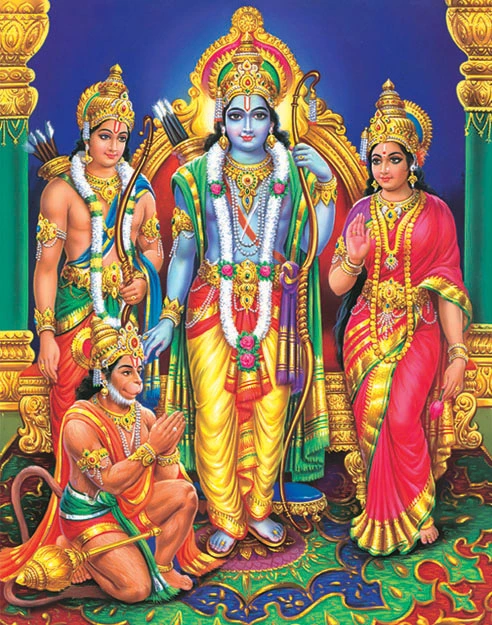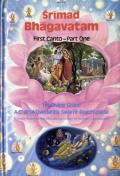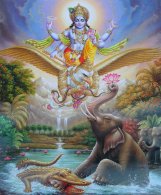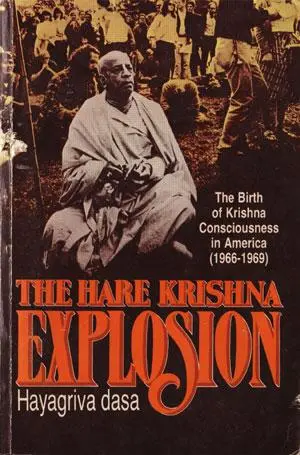16 Apr 2024
by The Hare Krishna Movement
in A. C. Bhaktivedanta Swami Prabhupada, Rama
Tags: A.C. Bhaktivedanta Swami Prabhupada, Krishna, Rama, Rama Navami, Srila Prabhupada, Srimad Bhagavatam
So today is the appearance day of Lord Ramachandra or Rama-Navami. We honor it with a fast untill sunset, followed by a nice vegetarian feast. It is good to read and chant throughout the day and remind each other about the glorious pastimes of Lord Ramachandra.
In honor of the Appearance day of Lord Ramacandra, we are posting the entire tenth chapter from the ninth Canto of Srimad Bhagavatam entitled “The Pastimes of the Supreme Lord, Rāmacandra”.
Śrīmad-Bhāgavatam
By His Divine Grace A. C. Bhaktivedanta Swami Prabhupāda
Canto Nine, Chapter Ten
The Pastimes of the Supreme Lord, Rāmacandra
Full chapter
More
21 Apr 2021
by The Hare Krishna Movement
in A. C. Bhaktivedanta Swami Prabhupada, Lord Ramachandra, Rama
Tags: A. C. Bhakthvedanta Swami Prabhupada, appearance day of Lord Ramacandra, Lord Ramacandra, Rama, Rama Navami, ravana Ayodhya, sita rama, son of Dasaratha, son of Raghu, the pastimes of the supreme lord ramacandra
So today is the appearance day of Lord Ramachandra or Rama-Navami. We honor it with a fast untill sunset, followed by a nice vegetarian feast. It is good to read and chant throughout the day and remind each other about the glorious pastimes of Lord Ramachandra.
In honor of the Appearance day of Lord Ramacandra, we are posting the entire tenth chapter from the ninth Canto of Srimad Bhagavatam entitled “The Pastimes of the Supreme Lord, Rāmacandra”.
Śrīmad-Bhāgavatam
By His Divine Grace A. C. Bhaktivedanta Swami Prabhupāda
Canto Nine, Chapter Ten
The Pastimes of the Supreme Lord, Rāmacandra
Full chapter
More
02 Apr 2020
by The Hare Krishna Movement
in A.C. Bhaktivedanta Swami Prabhupada, Festivals, Lectures, Rama, Rama Navami
Tags: A, A. C. Bhakthvedanta Swami Prabhupada, appearance day of Lord Ramacandra, Ayodhya India, Hanuman, Laksmana, Lecture by Srila Prabhupada, Rama, Rama Navami, Ramadi, Ravana, Sita
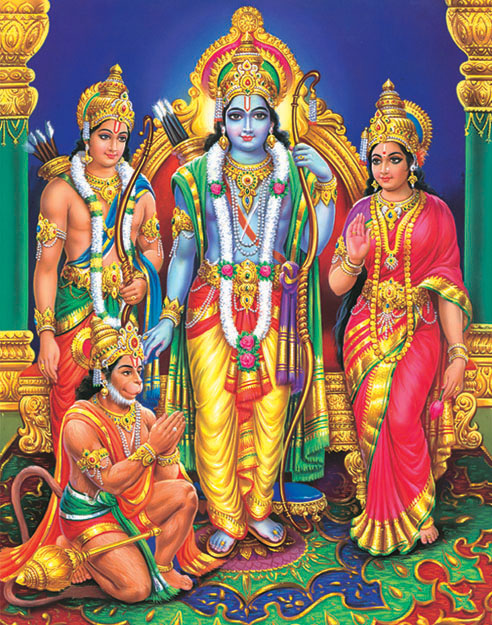
Today we are celebrating Śrī Rāma-Navamī, Lord Rāmacandra’s Appearance Day. We are honoring it with a fast until sunset, followed by a nice vegetarian feast. We are including a lecture by Srila Prabhupada on the appearance of Lord Ramachandra
…So Rāmacandra’s life, God’s activities, pastimes, if we hear, that means we are associating with Rāmacandra. There is no difference between His form, His name, His pastimes, and Himself. He’s absolute. Therefore either you chant the holy name of Rāma or you see the statue of Rāma or you talk of His pastimes, transcendental pastimes, everything, that means you are associating with the Supreme Personality of Godhead. So we take advantage of these days when the incarnation of God appears or disappears, and we try to associate with Him. By His association we become purified. Our process is purification. Kṛṣṇa consciousness means simply we are purifying our consciousness. (Lecture by His Divine Grace A. C. Bhaktivedanta Swami Prabhupada
Recorded in Hawaii, March 27, 1969)
Full Lecture More
15 Apr 2016
by The Hare Krishna Movement
in A.C. Bhaktivedanta Swami Prabhupada, Krsna is the Source of All Incarnations, Rama
Tags: A.C. Bhaktivedanta Swami Prabhupada, Kṛṣṇa Is the Source of All Incarnations, Lord Rama, Maharaja Dasaratha, Maharaja Iksvaku, Personality of Godhead eighteenth incarnation, Rama, Ramacandra, Ravana, SB1.3.22, SB2.7.23, SB2.7.24, SB2.7.25, Sita, Srimad Bhagavatam

Today we celebrate the appearance of Lord Ramacandra with an all day fast, and hearing of Lord Rama’s pastimes. I went to the Srimad Bhagavatam this morning and did a little reading from the First Canto, Chapter 2 entitled “Kṛṣṇa Is the Source of All Incarnations”, and from the Second Canto, Chapter 7 entitled “Scheduled Incarnations with Specific Functions”. I have included some verses below.
Śrīmad-Bhāgavatam
By His Divine Grace A. C. Bhaktivedanta Swami Prabhupāda
Canto One, Chapter 2, Text 22
nara-devatvam āpannaḥ
sura-kārya-cikīrṣayā
samudra-nigrahādīni
cakre vīryāṇy ataḥ param
nara—human being; devatvam—divinity; āpannaḥ—having assumed the form of; sura—the demigods; kārya—activities; cikīrṣayā—for the purpose of performing; samudra—the Indian Ocean; nigraha-ādīni—controlling, etc.; cakre—did perform; vīryāṇi—superhuman prowess; ataḥ param—thereafter.
TRANSLATION
In the eighteenth incarnation, the Lord appeared as King Rāma. In order to perform some pleasing work for the demigods, He exhibited superhuman powers by controlling the Indian Ocean and then killing the atheist King Rāvaṇa, who was on the other side of the sea.
PURPORT
The Personality of Godhead Śrī Rāma assumed the form of a human being and appeared on the earth for the purpose of doing some pleasing work for the demigods or the administrative personalities to maintain the order of the universe. Sometimes great demons and atheists like Rāvaṇa and Hiraṇyakaśipu and many others become very famous due to advancing material civilization by the help of material science and other activities with a spirit of challenging the established order of the Lord. For example, the attempt to fly to other planets by material means is a challenge to the established order. The conditions of each and every planet are different, and different classes of human beings are accommodated there for particular purposes mentioned in the codes of the Lord. But, puffed up by tiny success in material advancement, sometimes the godless materialists challenge the existence of God. Rāvaṇa was one of them, and he wanted to deport ordinary men to the planet of Indra (heaven) by material means without consideration of the necessary qualifications. He wanted a staircase to be built up directly reaching the heavenly planet so that people might not be required to undergo the routine of pious work necessary to enter that planet. He also wanted to perform other acts against the established rule of the Lord. He even challenged the authority of Śrī Rāma, the Personality of Godhead, and kidnapped His wife, Sītā. Of course Lord Rāma came to chastise this atheist, answering the prayer and desire of the demigods. He therefore took up the challenge of Rāvaṇa, and the complete activity is the subject matter of the Rāmāyaṇa. Because Lord Rāmacandra was the Personality of Godhead, He exhibited superhuman activities which no human being, including the materially advanced Rāvaṇa, could perform. Lord Rāmacandra prepared a royal road on the Indian Ocean with stones that floated on the water. The modern scientists have done research in the area of weightlessness, but it is not possible to bring in weightlessness anywhere and everywhere. But because weightlessness is the creation of the Lord by which He can make the gigantic planets fly and float in the air, He made the stones even within this earth to be weightless and prepared a stone bridge on the sea without any supporting pillar. That is the display of the power of God.
More
28 Mar 2015
by The Hare Krishna Movement
in A.C. Bhaktivedanta Swami Prabhupada, Rama, Srimad Bhagavatam
Tags: A.C. Bhaktivedanta Swami Prabhupada, Bharata, Laksmana, Lord Ramacandra, Maharaja Dasratha, mother Sita, Rama, Ramayana, Ravana kidnapped Sita, Satrughnna, Sita, Srimad Bhagavatam, the Absolute Truth Himself, The Supreme Personality of Godhead, visnu-tattva

In honor of the Appearance day of Lord Ramacandra, we are posting the entire tenth chapter from the ninth Canto of Srimad Bhagavatam entitled “The Pastimes of the Supreme Lord, Rāmacandra”.
Śrīmad-Bhāgavatam
By His Divine Grace A. C. Bhaktivedanta Swami Prabhupāda
Canto Nine, Chapter Ten
More
19 Apr 2013
by The Hare Krishna Movement
in A.C. Bhaktivedanta Swami Prabhupada, Lectures, Rama
Tags: God, God disposes, God's desire, Lecture by Srila Prabhupada, Lord Ramachndra's Appearance Day, Rama, Srimad Bhagavatam

In honor of the Appearance Day of Lord Ramachandra, we are posting a Lecture given by His Divine Grace A.C. Bhaktivedanta Swami Prabhupada from way back in 1966, when many of us here in the Western world were just hearing about Rama, and His amazing pastimes, for the very first time.
…When God comes in incarnation or He sends His representative to reclaim, they perform wonderful acts. They are not ordinary, common men. Either God or God’s representative, they act in such a way that it is not possible for any common man. That is the particular symptom of God and God’s representative. (Ramachandra’s Appearance Day Lecture, December 27, 1966 New York)
Full Lecture More
29 Apr 2012
by The Hare Krishna Movement
in Rama
Tags: A.C. Bhaktivedanta Swami Prabhupada, goddess of fortune, Laksmiji, Lord Ramachandra, Ravana, Sita, sita rama, Sitaji, Sri Ramacandra, Srimad Bhagavatam

In honor of the Appearance Day of Sita Devi, Wife of Lord Ramachandra, we post a short excerpt from Srila Prabhupada’s Srimad Bhagavatam.
…Sītā is Lakṣmījī, or the goddess of fortune, but she is never to be enjoyed by any living being. She is meant for being worshiped by the living being along with her husband, Śrī Rāmacandra. A materialistic man like Rāvaṇa does not understand this great truth, but on the contrary he wants to snatch Sītādevī from the custody of Rāma and thus incurs great miseries. The materialists, who are after opulence and material prosperity, may take lessons from the Rāmāyaṇa that the policy of exploiting the nature of the Lord without acknowledging the supremacy of the Supreme Lord is the policy of Rāvaṇa. Rāvaṇa was very advanced materially, so much so that he turned his kingdom, Laṅkā, into pure gold, or full material wealth. But because he did not recognize the supremacy of Lord Rāmacandra and defied Him by stealing His wife, Sītā, Rāvaṇa was killed, and all his opulence and power were destroyed.
Srimad Bhagavatam
By His Divine Grace A.C. Bhaktivedanta Swami Prabhupada
Canto 2, Chapter 7, Text 23
Scheduled Incarnations with Specific Functions
asmat-prasāda-sumukhaḥ kalayā kaleśa
ikṣvāku-vaṁśa avatīrya guror nideśe
tiṣṭhan vanaṁ sa-dayitānuja āviveśa
yasmin virudhya daśa-kandhara ārtim ārcchat
asmat—unto us, beginning from Brahmā down to the insignificant ant; prasāda—causeless mercy; sumukhaḥ—so inclined; kalayā—with His plenary extensions; kaleśaḥ—the Lord of all potencies; ikṣvāku—Mahārāja Ikṣvāku, in the dynasty of the sun; vaṁśe—family; avatīrya—by descending in; guroḥ—of the father or spiritual master; nideśe—under the order of; tiṣṭhan—being situated in; vanam—in the forest; sa-dayitā-anujaḥ—along with His wife and younger brother; āviveśa—entered; yasmin—unto whom; virudhya—being rebellious; daśa-kandharaḥ—Rāvaṇa, who had ten heads; ārtim—great distress; ārcchat—achieved.
Due to His causeless mercy upon all living entities within the universe, the Supreme Personality of Godhead, along with His plenary extensions, appeared in the family of Mahārāja Ikṣvāku as the Lord of His internal potency, Sītā. Under the order of His father, Mahārāja Daśaratha, He entered the forest and lived there for considerable years with His wife and younger brother. Rāvaṇa, who was very materially powerful, with ten heads on his shoulders, committed a great offense against Him and was thus ultimately vanquished.
More
30 Mar 2012
by The Hare Krishna Movement
in Lectures, Rama
Tags: A.C. Bhaktivedanta Swami Prabhupada, appearance of Lord Ramacandra, Lord Ramacandra, Rama, Rama Navami, Ramacandra, Ramadi, Sri Rama-navami lecture, Treta-yuga

…So Rāmacandra’s life, God’s activities, pastimes, if we hear, that means we are associating with Rāmacandra. There is no difference between His form, His name, His pastimes, and Himself. He’s absolute. Therefore either you chant the holy name of Rāma or you see the statue of Rāma or you talk of His pastimes, transcendental pastimes, everything, that means you are associating with the Supreme Personality of Godhead. So we take advantage of these days when the incarnation of God appears or disappears, and we try to associate with Him. By His association we become purified. Our process is purification. Kṛṣṇa consciousness means simply we are purifying our consciousness.
Śrī Rāma-Navamī, Lord Rāmacandra’s Appearance Day
By His Divine Grace A.C. Bhaktivedanta Swami Prabhupada
Hawaii, March 27, 1969
(kīrtana)
Prabhupāda: (chants maṅgalācaraṇa prayers)
rāmādi mūrtiṣu kalā-niyamena tiṣṭhan
nānāvatāram akarod bhuvaneṣu kintu
kṛṣṇaḥ svayaṁ samabhavat paramaḥ pumān yo
govindam ādi-puruṣaṁ tam ahaṁ bhajāmi
[Bs. 5.39]
This is a verse from Brahma-saṁhitā in which the incarnation of Lord Rāmacandra is described. Rāmādi. Not only Rāma, but there are many other, innumerable incarnations. They are compared with the waves of a river. As the waves of the river or the waves of the ocean cannot be counted, similarly, how many incarnations are there of the Supreme Lord it is not possible to count. But out of them, the principal names are mentioned in the śāstras. Therefore it is said rāmādi. Rāmādi means Rāma and also other, many incarnations. And they are existing. Not that one incarnation appeared and it is finished. No. Not like that. Just like Lord Rāmacandra appeared on this planet, say millions of years before. He appeared in the Treta-yuga. Treta-yuga means… We have passed only five thousand years of this age, Kali-yuga. Before that, there was Dvāpara-yuga. Dvāpara-yuga means 800,000 years. And before that, there was Tretā-yuga, which continued for twelve hundred thousands of years. That means at least two million years before Lord Rāmacandra appeared on this planet.
More
29 Mar 2012
by The Hare Krishna Movement
in Krsna is the Source of All Incarnations, Rama
Tags: A.C. Bhaktivedanta Swami Prabhupada, Hanuman, Rama, Ravana, Sita, Sri Rama, Srimad Bhagavatam, The Pewrsonality of Godhead

Srimad Bhagavatam
By His Divine Grace A.C. Bhaktivedanta Swami Prabhupada
Canto 1, Chapter 3, Text 22
Krsna Is the Source of All Incarnations
nara-devatvam āpannaḥ
sura-kārya-cikīrṣayā
samudra-nigrahādīni
cakre vīryāṇy ataḥ param
nara—human being; devatvam—divinity; āpannaḥ—having assumed the form of; sura—the demigods; kārya—activities; cikīrṣayā—for the purpose of performing; samudra—the Indian Ocean; nigraha-ādīni—controlling, etc.; cakre—did perform; vīryāṇi—superhuman prowess; ataḥ param—thereafter.
In the eighteenth incarnation, the Lord appeared as King Rāma. In order to perform some pleasing work for the demigods, He exhibited superhuman powers by controlling the Indian Ocean and then killing the atheist King Rāvaṇa, who was on the other side of the sea.
Purport
The Personality of Godhead Śrī Rāma assumed the form of a human being and appeared on the earth for the purpose of doing some pleasing work for the demigods or the administrative personalities to maintain the order of the universe. Sometimes great demons and atheists like Rāvaṇa and Hiraṇyakaśipu and many others become very famous due to advancing material civilization by the help of material science and other activities with a spirit of challenging the established order of the Lord. For example, the attempt to fly to other planets by material means is a challenge to the established order. The conditions of each and every planet are different, and different classes of human beings are accommodated there for particular purposes mentioned in the codes of the Lord. But, puffed up by tiny success in material advancement, sometimes the godless materialists challenge the existence of God. Rāvaṇa was one of them, and he wanted to deport ordinary men to the planet of Indra (heaven) by material means without consideration of the necessary qualifications. He wanted a staircase to be built up directly reaching the heavenly planet so that people might not be required to undergo the routine of pious work necessary to enter that planet. He also wanted to perform other acts against the established rule of the Lord. He even challenged the authority of Śrī Rāma, the Personality of Godhead, and kidnapped His wife, Sītā. Of course Lord Rāma came to chastise this atheist, answering the prayer and desire of the demigods. He therefore took up the challenge of Rāvaṇa, and the complete activity is the subject matter of the Rāmāyaṇa. Because Lord Rāmacandra was the Personality of Godhead, He exhibited superhuman activities which no human being, including the materially advanced Rāvaṇa, could perform. Lord Rāmacandra prepared a royal road on the Indian Ocean with stones that floated on the water. The modern scientists have done research in the area of weightlessness, but it is not possible to bring in weightlessness anywhere and everywhere. But because weightlessness is the creation of the Lord by which He can make the gigantic planets fly and float in the air, He made the stones even within this earth to be weightless and prepared a stone bridge on the sea without any supporting pillar. That is the display of the power of God.
11 Apr 2011
by The Hare Krishna Movement
in Rama
Tags: Hindus, incarnation of Lord Visnu, Lord Rama, Rama, Rama Navami, Ramanavami, Ramayana, Shukla Paksha
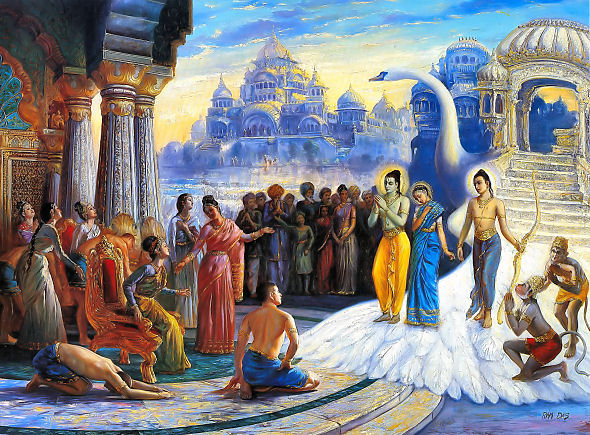
Rama Navami – the birthday of Lord Rama
Pasted from prabhupadanugas.eu
Rama Navami (Devanāgarī: राम नवमी) also known as Sri Rama Navami ( IAST SriRāma-navamī ). Sri Ram Navami is a great festival in India, celebrating the birth of Lord Rama to King Dasharatha and Queen Kausalya of Ayodhya. Rama is the 7th incarnation of the Dashavatara of Vishnu. The festival falls in the Shukla Paksha on the Navami, the ninth day of the month of Chaitra in the Hindu calendar. Thus it is also known as Chaitra Masa Suklapaksha Navami, and marks the end of the nine-day Chaitra-Navratri celebrations.
More


